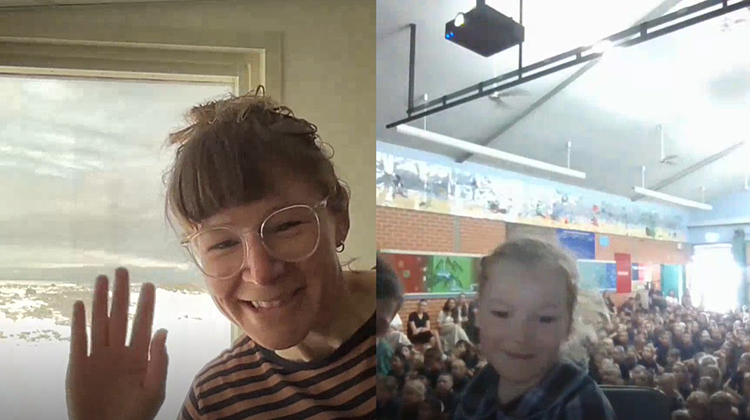A Cool Opportunity: Video Cross Between Students and Scientist in Antarctica

When a major windstorm with gusts of more than 200 kilometres per hour damaged special air sampling equipment in Antarctica, CSIRO senior research scientist Dr Ann Stavert packed her bags and made the journey to one of the world’s most remote research labs to replace it.
The instrumentation is installed on a small red hut affectionately known as ‘Mabel’ by those based at Casey Station, and is used to measure greenhouse gases continuously in a monitoring operation that has been ongoing for more than 30 years. Ann is one of few Australians able to get the research up and running again.
As well as providing this important service for research, Ann made the trip doubly valuable by taking some time to connect via a live video cross with her six-year-old daughter and more than 500 of her peers at an Illawarra based public school to share with them what it is like working as a scientist in Antarctica.
Connecting Students to Science in the Field
Despite a physical separation of more than 4000 kilometres, Ann was able to connect directly with the school’s specialist STEM teacher, Lisa Macdonald, while all students from kindergarten to year six watched on for one of the ‘coolest’ Microsoft Teams meetings on offer.
For half an hour the students learned about life at Casey Station including what they wear to stay warm, how they get food, what local wildlife can be found, and about the number of occupations that play an important role on site.
Ann shared about her work measuring carbon dioxide (“the air we breathe out”) and methane (“cow burps”), among other gases found in Antarctic air samples. She explained that CSIRO measure the air in two ways at Casey. They have an instrument that makes continuous measurements, and also fortnightly air samples are collected in flasks to be sent back to a lab in Melbourne for analysing for many other gases. The findings are shared with the international science community to observe how the earth’s atmosphere is changing over time.
A short, pre-recorded video took the students on an outdoor tour of the station site including Mabel Hut, the endemic moss known as the ‘rainforest of Antarctica’ and the surrounding icy landscapes.
This was followed by an enthusiastic question time kicked off by Ann’s own daughter. Students of all ages asked questions ranging from the current temperature in Antarctica (a mild -1 degrees), to how Ann was able to secure an internet connection, and whether she had seen an aurora.
Long-lasting Learning Impact
School teacher Lisa said the experience created a memorable and impactful learning opportunity, leaving a lasting impression on students and encouraging a sustained interest in science.
“The live stream provided inspiration and motivation for students to pursue careers in STEM fields, offering a firsthand look at the exciting possibilities and impact of scientific research.
“Many of them went back to their classrooms and wrote about what they would like to do in Antarctica in the future - a scientist, a sparky or a chef! It broadened students' career horizons by introducing them to a less common but fascinating career path.
“This unique encounter not only broadened our students' career horizons but also showcased the power of real-world connections in shaping their educational journeys. We extend our heartfelt thanks to Ann Stavert for sharing her expertise and passion, making this an unforgettable experience for our entire school community.”
CSIRO STEM Professionals in Schools
Ann and Lisa were introduced through CSIRO’s STEM Professionals in Schools program, which connects teachers all around Australia with professionals like Ann working in science, technology, engineering and maths (STEM) fields in order to bring real world STEM to the classroom.
In this case, Ann dialled in from a remarkable location, but Lisa says the benefit lies in the collaboration between educators and STEM professionals regardless of their location.
“As a teacher, partnering with ‘STEM Professionals in Schools’ proves highly advantageous. This collaboration enriches teaching resources, offers valuable networking opportunities, and supports engaging project-based learning initiatives.
“The presence of STEM professionals not only inspires students by providing motivational role models but also encourages collaborative efforts among teachers from different disciplines.
“It enhances community engagement and showcases our school's dedication to preparing students for future STEM careers and establishing a meaningful bridge between our educational setting and the professional world.”
Thirty Minutes Well Spent
From Ann’s perspective, the live cross was a worthwhile way to spend a small part of her day, adding more to the variety of things she finds herself doing as part of her job.
“Every day is a little bit different, and I do everything from writing computer code to process and analyse data, to talking to other scientists about what the data is telling us, to tinkering in a remote location with a spanner. I love the combination of skills required - research, logic and practical hands-on work."
The trip was Ann’s fifth to Antarctica, and she considered the live video chat with the school a great opportunity to show her daughter and her friends why the travel and the research is so important.
“Science is interesting, and challenging, and important! We need to encourage our kids to study it because the world is changing and we will need future scientists, engineers and mathematicians to help us understand it, and how to best live in it.”
Would you like to partner with a STEM Professional or a teacher in 2024? Visit csiro.au/STEM-Professionals-in-Schools.